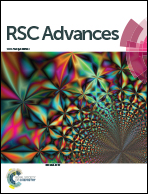An efficient way to reduce graphene oxide by water elimination using phosphoric acid†
Abstract
This study concerns the synthesis of high-quality graphene by the water elimination reaction in the presence of phosphoric and sulfuric acid (H3PO4–G and H2SO4–G). Graphene was synthesized via a single-step efficient reduction method which is not yet found in the literature. This new method is called the acidic method and offers significant advantages, such as absence of toxic products, ease of purification and a high-quality graphene yield. Graphene formation from graphene oxide (GO) was verified by the use of Fourier transform infrared spectroscopy (FT-IR), raman spectroscopy, X-ray diffraction (XRD) and X-ray photoelectron spectroscopy (XPS). Thermal properties and the surface morphology of the graphene obtained were elucidated by the use of thermogravimetric analysis (TGA) and transmission electron microscopy (TEM). H3PO4–G prepared by this method was observed to have a very high conductivity value of 3860 S m−1 and a low capacitance value of 114 F g−1 cm2. The capacitance and conductivity values of graphene samples obtained with the conventional method by the use of sodium borohydride (NaBH4–G) as a reducing agent were compared with those obtained with the acidic reduction method. It was seen that the acidic reduction method showed promising features for the production of high-quality graphene and its applications.


 Please wait while we load your content...
Please wait while we load your content...